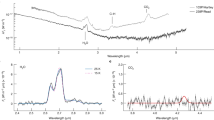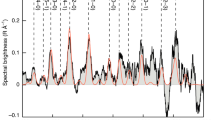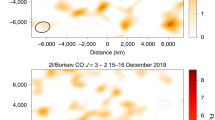Abstract
COMETS are rich in volatile materials, of which roughly 80% (by number) are water molecules1. Considerable progress2–4 is being made in identifying the other volatile species, the abundances of which should enable us to determine whether comets formed primarily from ice-covered interstellar grains5, or from material that was chemically processed in the early solar nebula6,7. Here we report the detection of acetylene (C2H2) in the infrared spectrum of comet C/1996 B2 (Hyakutake). The estimated abundance is 0.3–0.9%, relative to water, which is comparable to the predicted solid-phase abundance in cold interstellar clouds. This suggests that the volatiles in comet Hyakotake may have come from ice-covered interstellar grains, rather than material processed in the accretion disk out of which the Solar System formed.
This is a preview of subscription content, access via your institution
Access options
Subscribe to this journal
Receive 51 print issues and online access
$199.00 per year
only $3.90 per issue
Buy this article
- Purchase on Springer Link
- Instant access to full article PDF
Prices may be subject to local taxes which are calculated during checkout
Similar content being viewed by others
References
Krankowsky, D. et al. Nature 321, 326–329 (1986).
Bockelée-Morvan, D., Colom, P., Crovisier, J., Despois, D. & Paubert, G. Nature 350, 318–320 (1991).
Mumma, M. J., Weissman, P. R. & Stern, S. A. in Protostars and Planets III (eds Levy, E. H. & Lunine, J. I.) 1177–1252 (Univ. Arizona Press, Tucson, 1993).
Mumma, M. J. et al. Science 272, 1310–1314 (1996).
Greenberg, J. M. in Comets (ed. Wilkening, L. L.) 131–163 (Univ. Arizona Press, Tucson, 1982).
Fegley, B. & Prinn, R. G. in The Formation and Evolution of Planetary Systems (eds Weaver, H. A. & Danly, L) 171–211 (Cambridge Univ. Press, Cambridge, 1989).
Lunine, J. I. in The Formation and Evolution of Planetary Systems (eds Weaver, H. A. & Danly, L.) 213–242 (Cambridge Univ. Press, Cambridge, 1989).
Tokunaga, A. T., Toomey, D. W., Carr, J., Hall, D. N. B. & Epps, H. W. Proc. SPIE 1235, 131–143 (1990).
Greene, T. P., Tokunaga, A. T., Toomey, D. W. & Carr, J. S. Proc. SPIE 1946, 313–324 (1993).
Meadows, V. S. & Crisp, D. J. Geophys. Res. 101, 4595–4622 (1996).
Herzberg, G. Molecular Spectra and Molecular Structure Vol II, Infrared and Raman Spectra of Polyatomic Molecules (Van Nostrand Reinhold, New York, 1945).
Crovisier, J. & Encrenaz, Th. Astron. Astrophys. 126, 170–182 (1983).
Weaver, H. A. & Mumma, M. J. Astrophys. J. 276, 782–797 (1984).
Schleicher, D. G. & A'Hearn, M. F. Astrophys. J. 331, 1058–1077 (1988).
Crovisier, J. Astron. Astrophys. 213, 459–464 (1989).
Bockelée-Morvan, D. & Crovisier, J. Astron. Astrophys. 216, 278–283 (1989).
Crovisier, J. Astron. Astrophys. Suppl. Ser. 68, 223–258 (1987).
Vander Auwera, J., Hurtmans, D., Carleer, M. & Herman, M. J. Mol. Spectrosc. 157, 337–357 (1993).
Wootten, A. et al. Abstr. Int. Conf. on Asteroids, Comets, Meteors 39 (Observatoire de Paris, Meudon, 1996).
Matthews, H. E. et al. IAU Circ. No. 6353 (1996).
Womack, M., Festou, M. C. & Stern, S. A. IAU Circ. No. 6345 (1996).
Jackson, W. M. J. Photochem. 5, 107–118 (1976).
Schleicher, D. IAU Circ. No. 6344 (1996).
Huebner, W. F., Keady, J. J. & Lyon, S. P. Astrophys. Space Sci. 195, 1–294 (1992).
O'Dell, C. R., Robinson, R. R., Krishna Swamy, K. S., McCarthy, P. J. & Spinrad, H. Astrophys. J. 334, 476–488 (1988).
Yamamoto, T. in Comets in the Post-Halley Era (eds Newburn, R. L. Jr, Neugebauer, M. & Rahe, J.) 361–376 (Kluwer, Dordrecht, 1991).
Prinn, R. G. & Fegley, B. Astrophys. J. 249, 308–317 (1981).
Strazzulla, G. & Johnson, R. E. in Comets in the Post-Halley Era (eds Newburn, R. L. Jr, Neugebauer, M. & Rahe, J.) 243–275 (Kluwer, Dordrecht, 1991).
Carr, J. S., Evans, N. J., Lacy, J. H. & Zhou, S. Astrophys. J. 450, 667–690 (1995).
Hasegawa, T. I. & Herbst, E. Mon. Not. R. Astron. Soc. 263, 589–606 (1993).
Author information
Authors and Affiliations
Rights and permissions
About this article
Cite this article
Brooke, T., Tokunaga, A., Weaver, H. et al. Detection of acetylene in the infrared spectrum of comet Hyakutake. Nature 383, 606–608 (1996). https://doi.org/10.1038/383606a0
Received:
Accepted:
Issue Date:
DOI: https://doi.org/10.1038/383606a0
This article is cited by
-
Detection of polycyclic aromatic hydrocarbons on a sample of comets
Journal of Astrophysics and Astronomy (2023)
-
A plasma-assisted cataluminescence sensor for ethyne detection
Analytical and Bioanalytical Chemistry (2016)
Comments
By submitting a comment you agree to abide by our Terms and Community Guidelines. If you find something abusive or that does not comply with our terms or guidelines please flag it as inappropriate.



